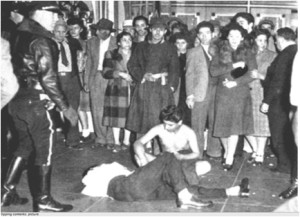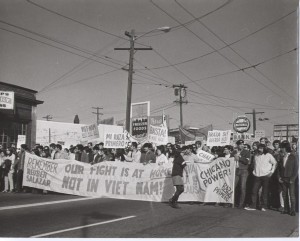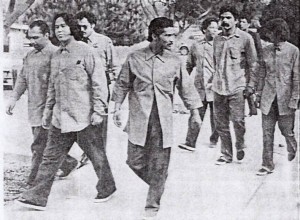In her Article entitled “Isolation and Stigmatization in the Development of an Underclass: The Case of Chicano Gangs in East Los Angeles” Joan W. Moore traces the development of youth gangs in East Los Angeles. She identifies four key instances that worked to determine the reputation of these gangs. These events include the zoot suit riots, the rise of heroin use/dealing, the chicano movement, and the rise of major prison gangs. Three of these events worked to further stigmatize the gangs while one of them, the chicano movement, helped to reintegrate gang members into society.
I will start by discussing the zoot suit riots. Prior to the riots, gangs were usually not seen as a major threat and generally accepted in their communities. They were simply a small nuisance that most people put up with. The Zoot suit riots changed this perception however. Partially through media exaggeration and generalization. During the zoot suit riots, any Mexican youth in a zoot suit was in danger, even if they weren’t associated with a gang. The way in which newspapers spoke about and generalized Mexican youth helped to perpetuate a negative image. For example, they were described as savage and their deviance was inherited from the “blood lust” of the Aztecs (6). The next event that she cites is the rise of heroin use among the chicano gangs of East L.A. Heroin use became popular among the barrio gangs, which worked to heighten their negative reputation.
The next event that she discusses, the chicano movement, actually helped to reassimilate gang members back into their communities. There were several reasons for this one being that the gangs started to be seen in a romantic way. They were fighting for the rights of their people. They also functioned as “soldiers” protecting women and children during demonstrations.
According to Moore, these sentiments didn’t last long. After the chicano movement died out, there came the rise of prison gangs. Anyone who had salvaged their reputation during the chicano movement now became associated with someone in the prison gangs and were shunned from the community again.
Her study highlights important trends among the chicano gang community. It suggests that gang violence correlates with the gangs public image. For example, if a gang has a negative reputation, they will work to uphold such a reputation. It also suggests that gang members can be re accepted back into society, as they were during the chicano movement. If something like this happened before, is it possible that gangs can become accepted again?
Works cited:
Moore, Joan W. “Isolation And Stigmatization In The Development Of An Underclass: The Case Of Chicano Gangs In East Los Angeles.” Social Problems 33.(1985): 1-12. Social Sciences Full Text (H.W. Wilson). Web. 11 Apr. 2014.
images:
http://research.pomona.edu/zootsuit/en/riots/




I believe this commentary on the evolution of gang life in East Los Angeles in incredibly pertinent to Viramontes’s novel considering the first character we are introduced to is Turtle, a former member of the McBride gang. The reference to a gang’s violence correlating to the gang’s public image can be seen in the aggression Turtle harbors within her on a constant basis. Undoubtedly stemming from the myriad of family issues she has experienced and the insecurity she feels in her own identity, this aggression and violence is furthered by her gang involvement. We see instances of her agitated demeanor in her first encounter with Tranquilina as she is crossing the street in the rain with the roast from the butcher, and when she sees the dark figure on the street corner whom she believes to be a rival gang member. The fact that her initial reaction originates from a place of violence and aggression reinforces the negative influence gang involvement can have on troubled youth as they feel the need to maintain a hardened exterior and uphold the reputation of the group their are affiliated with.
I believe it is possible that those involved in gang activity can become accepted back into the chicano community, a necessity being, however, that they move away from the criminal activity and violence that they have become predominantly associated with and reintroduce themselves to their chicano movement roots as “soldiers” fighting for the rights of their people.
In the future this post will be very helpful and insightful for those who are interested in reading, “ Their Dogs Came with Them.”
This post will educate and help the reader better understand the character of Turtle that Helena Maria Viaramontes introduced in her novel. When reading her novel, one can conclude that the isolated, homeless character named Turtle joined the McBride gang not only impress her older brother, but to also have a feel and sense of acceptance.
When looking at the history of gangs in Los Angeles, the Zoot Suiters often times joined gangs for acceptance and for a sense of protection. As time passed, the Zoot Suites eventually evolved into Pachucos in which they too joined gangs for acceptance and protection.
I believe that the history of Los Angles can sometimes be ignored, therefore, I find this post to be interesting and insightful.